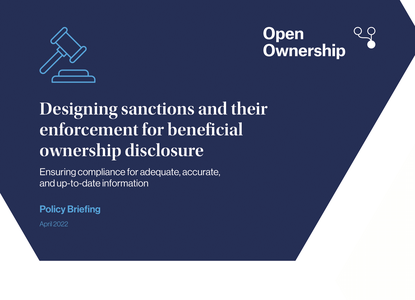Comparing compliance? Proceed with caution

Photo by Joe Roberts on Unsplash
Many agencies implementing beneficial ownership transparency (BOT) reforms, and those monitoring their progress, are concerned with questions of compliance. What is the rate of compliance with reporting requirements to our jurisdiction’s beneficial ownership (BO) register? How can we improve it? And what is a good compliance rate, anyway? These seem like straightforward questions, but there are several reasons that answering them can get complicated.
Compliance is neither consistently defined nor publicly reported
Corporate vehicles with an obligation to disclose information to a BO register have to meet several requirements to be compliant. These include submitting BO information that is complete, accurate, and provided in a timely manner, often on an ongoing basis. Noncompliance can therefore include non-submission or late submission of information, as well as the submission of incomplete, incorrect, or false information. Noncompliance can be a one-off incident, or it can be persistent. What a compliance rate measures therefore depends on which of these factors are being considered.
Most jurisdictions are still in the early stages of implementing registers and have only recently started collecting BO information, if they have at all. Those that do have not been publicly reporting compliance rates on a consistent basis, so there is very limited data so far on trends over time. If there were an established definition of compliance that was applied consistently within one jurisdiction to measure a rate over time, it may lead to useful trends analysis. However, variations between and a lack of public documentation about the definition being used can lead to limitations in the comparability of these figures between countries for a few reasons.
First, the rate may consider compliance with the different types of requirements mentioned above, such as the initial obligation to file following a register’s launch; subsequent timely filings; or completeness and accuracy of the most recent disclosures. Second, the rate may or may not include inactive companies. When inactive companies are excluded, rates will tend to be higher. Third, the compliance rate may be affected by an action of the registrar rather than a change in the behaviour of corporate vehicles with an obligation to make a BO disclosure, as discussed below.
Finally, a single aggregate figure for compliance will hide any variations between different types of corporate vehicles covered by a BO register. For example, disaggregating the data may show significant differences between limited partnerships, limited liability companies, and foundations within a single jurisdiction. Across jurisdictions, the types of corporate vehicles that can be legally formed and that are required to report will vary. Registers with a more limited scope may achieve higher compliance, but may also face risks from corporate vehicles that remain exempt.
Reported rates of compliance vary widely
Setting the definition issue aside, available information that has been reported on compliance suggests significant variation. For example, in 2019, 96% of all corporate vehicles covered by the BO regime had reportedly disclosed their BO information to Denmark’s central business register. Denmark has taken measures to support compliance, including clear guidance and dissuasive financial and administrative sanctions that can have direct impacts on a company’s ability to do business.
Austria’s business registry reports a similarly high rate of compliance with initial disclosure requirements. This has been aided by its robust verification regime, which includes accuracy checks both at and after the point of submission, as well as the consistent application of sanctions. For example, the registrar works with the tax agency to automatically generate letters warning noncompliant companies of an initial EUR 1,000 fine that increases with persistent noncompliance.
In contrast, the Ministry of Law and Human Rights of Indonesia, which manages the country’s central register, currently reports a compliance rate of around 40%. A 2024 study by Zambia’s Financial Intelligence Centre (FIC) reported that only 33% of legal persons and arrangements had disclosed their beneficial owners to the central register at the time of publication. The report also suggests improvements that could be made.
Barriers to compliance noted in the FIC report include limited sensitisation to the requirements among those obliged to disclose; disputes regarding control and ownership in some sectors, such as mining; and sanctions going unenforced. Experience from Open Ownership’s technical support for implementation of BOT suggests that low levels of compliance can also be due to factors including confusing data collection processes; lack of engagement with the private sector on the part of government; lack of enforcement of sanctions; and lack of clarity between inactivity and noncompliance.
The drivers are not clear, though sanctions likely play a central role
The examples given so far suggest what some useful measures might be to improve compliance, but it is difficult at this point to establish clear causal relationships between specific actions taken by a register and the level of compliance in different contexts.
Nevertheless, it seems reasonable to assume that the application of sanctions is one of the more effective means of encouraging compliance with BO disclosure. Multiple types of sanctions can be used, including administrative, financial, and criminal ones. Anecdotal experience of operationalising effective sanctions suggests that financial sanctions being set too low can lead to them being viewed as a cost of doing business rather than an incentive to comply.
Effectively applying sanctions can be challenging. For example, Reuters reported in May 2024 that Companies House, the United Kingdom (UK)’s corporate registry, had fined around 423 unregistered overseas entities a total of GBP 21.86 million (USD 27.7 million) for failing to file an initial declaration with the Register of Overseas Entities (ROE). However, less than 3% of the penalties had been paid at the time of writing. “Officials told Reuters some entities could have changed names, not updated land registry records or might no longer exist. But those that fail to register - along with their officers - face civil penalties, criminal prosecution and restrictions on their properties, including sales.”
Nonlinear patterns limit the comparability of compliance rates
Coverage of the roll out of the UK ROE also suggests that compliance with new reporting requirements does not follow a linear pattern (for example, see articles by the BBC and the Financial Times). Rather, it can be slow in the weeks and months following the launch of a register and then accelerate in the leadup to, and following, the deadline for initial reporting. Furthermore, actions taken by the registrar after launch can change the rate of compliance suddenly without it reflecting a change in the behaviour of reporting companies.
For example, Nigeria published a public notice that it would strike off noncompliant companies disclosed in a public list; it later published a shorter updated list, suggesting this had provided an incentive for active companies. A jump in the compliance rate may result when such a measure is implemented in bulk following the launch of a register, but this will reflect a change in the baseline value of total registered companies rather than an improvement in compliance behaviour among active companies.
Consultations, regular engagement, and sensitisation before reporting requirements are put in place are also no doubt important. However, it is challenging to quantify the value of these actions in terms of how they translate to improved compliance. More research is needed to understand how registrars can provide a service to companies and other corporate vehicles with a reporting obligation that supports a culture of high compliance.
Compliance rates should be reported but used with care
While there are not yet systematic studies of compliance rates with BO reporting requirements over time or between countries, some lessons can be drawn from jurisdictions’ experiences with implementation. Anecdotal evidence on the enablers and barriers to compliance offer inspiration on various types of measures that registrars can take to boost the timeliness and accuracy of disclosures. Examples include good communications to sensitise both old and new businesses to the requirements; automisation of reminder letters and the application of sanctions where possible; and the use of administrative sanctions that prevent companies from doing business.
Compliance rates are useful information that jurisdictions should routinely collect and publish to help citizens and monitoring organisations gauge the success of BOT reforms. They should do so alongside a clear definition and documentation about how the rate was calculated. Where registrars or policymakers are interested in multiple forms of compliance – for example including and excluding estimates of inactive companies – multiple rates could be reported. This approach can offer a means of understanding change over time in a jurisdiction.
However, even if reporting compliance becomes common practice, people interested in assessing BOT reforms across multiple jurisdictions will need to take care in comparing compliance rates. An internationally standardised approach to defining, measuring, and reporting compliance would be needed for robust comparisons to be made, and deciding on such an approach may prove challenging. Even then, using compliance rates would be most useful for within – rather than between – country comparisons. For instance, if accuracy and completeness are being considered as part of compliance, how this is understood may be difficult to standardise given diverse approaches to verification. In contrast, if a simpler approach were universally used, such as only measuring timely filings, this would miss nuances that may be important to some actors. Therefore, compliance rates will need to be treated with caution for the foreseeable future.
Related articles and publications
Publication type
Emerging thinking
Blog post
Sections
Impact,
Implementation
Open Ownership Principles
Sanctions and enforcement
